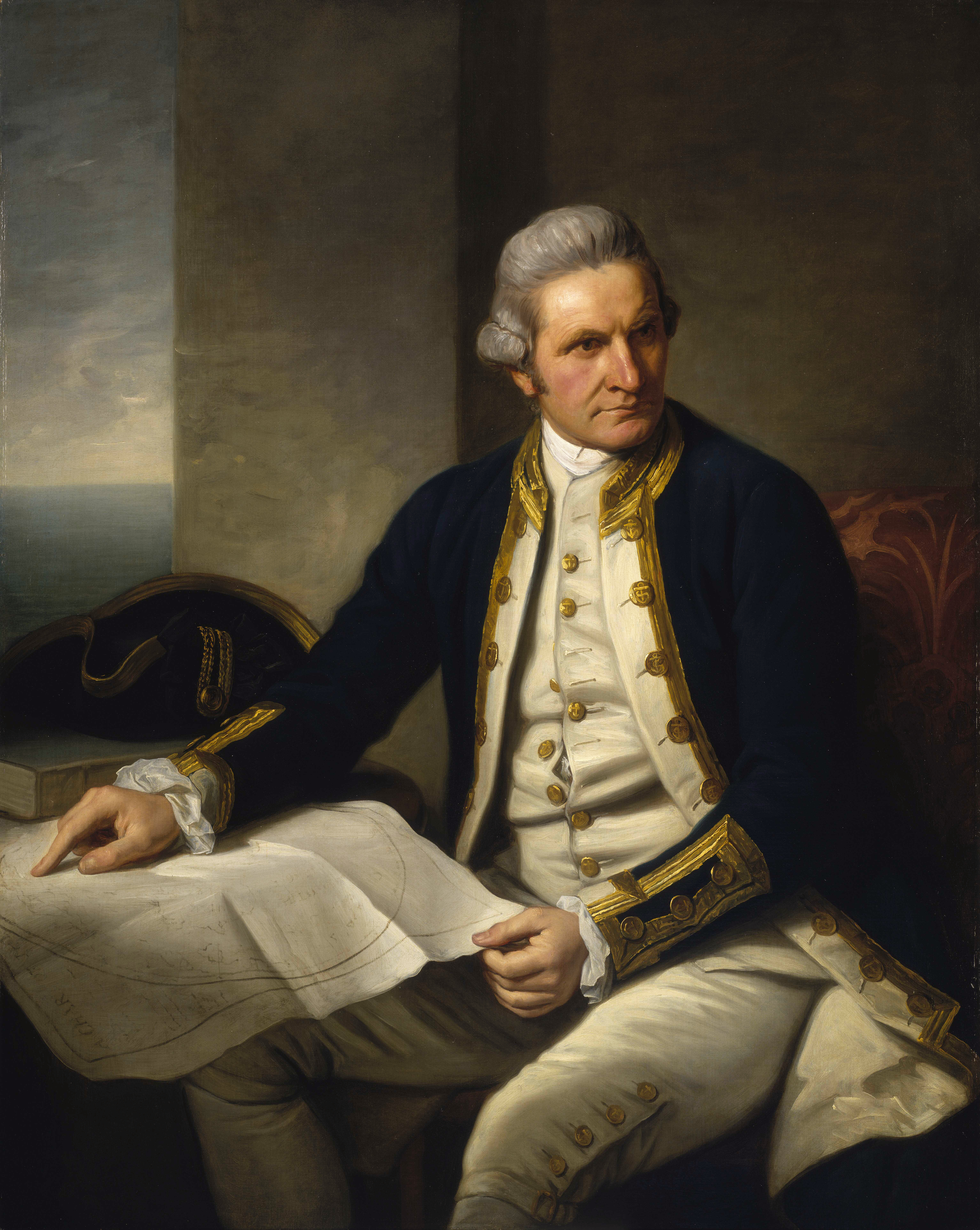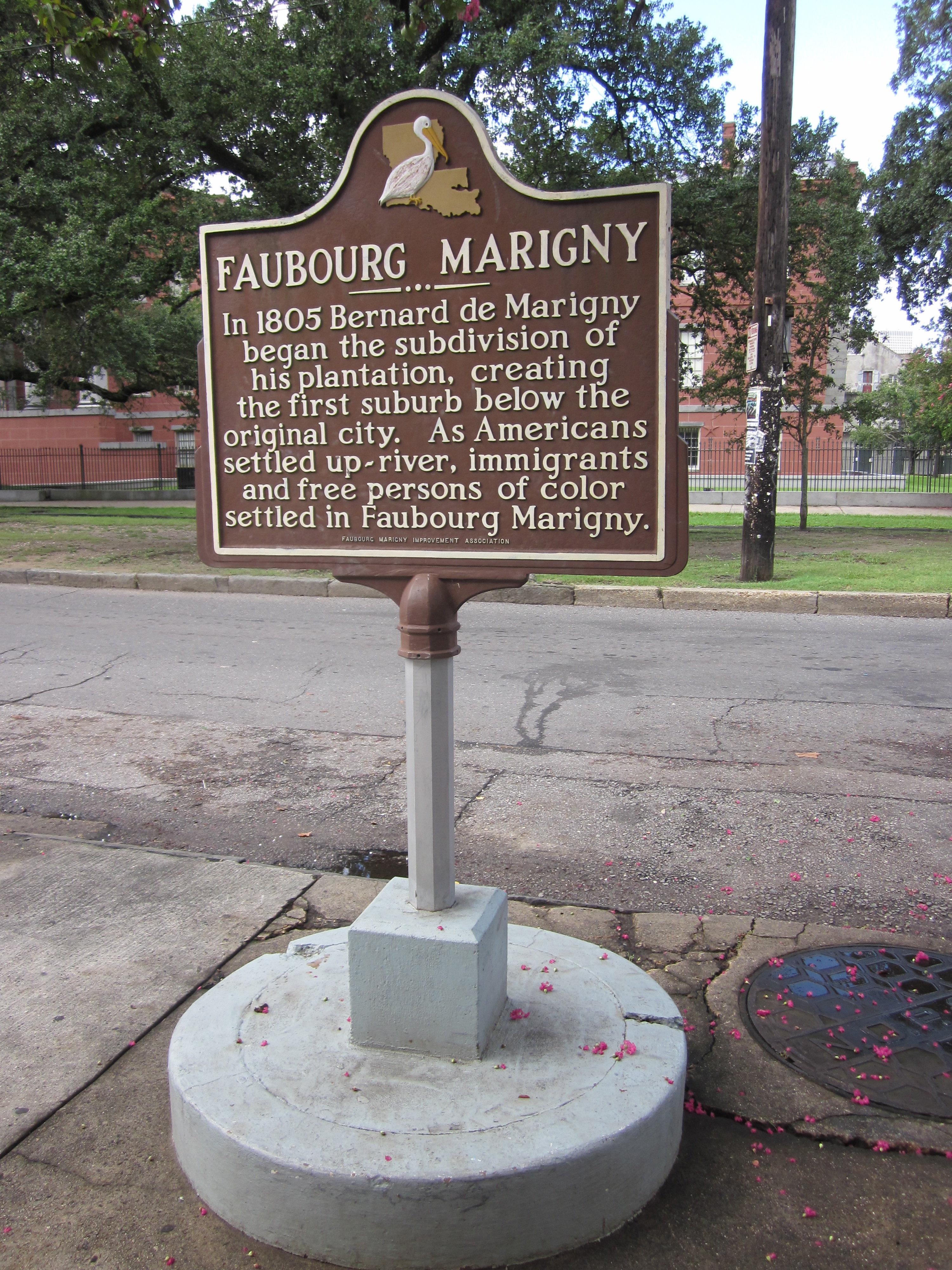|
Antoine Philippe De Marigny
Antoine Philippe de Marigny de Mandeville (17 July 1721 – 6 November 1779), Chevalier de St. Louis, was a French geographer and explorer. Born in Mobile in 1722, he was part of the Creole elite of French Louisiana. Biography Antoine Philippe de Marigny was born in Mobile in 1721, among the earliest French colonists born there. His parents were François Philippe de Marigny de Mandeville, a native of Bayeux who migrated to Canada in 1709 and then to Louisiana by 1714; and Madeleine le Maire. Considered a Creole because of his birth in La Louisiane, de Marigny belonged to a family that was part of the minor provincial nobility of France. Their paternal ancestor Pierre Philippe de Marigny de Mandeville was ennobled in 1654. After her husband's death, the widow Madeleine de Marigny married the colony's royal engineer, Ignace François Broutin. In 1748, Antoine de Marigny married Françoise de Lisle, thought to be the daughter of Guillaume Delisle. They had two children: ... [...More Info...] [...Related Items...] OR: [Wikipedia] [Google] [Baidu] |
Mobile, Alabama
Mobile ( , ) is a city and the county seat of Mobile County, Alabama, United States. The population was 187,041 at the 2020 United States census, 2020 census. After a successful vote to annex areas west of the city limits in July 2023, Mobile's population increased to 204,689 residents, making it the List of municipalities in Alabama, second-most populous city in Alabama. Mobile is the principal municipality of the Mobile metropolitan area. Alabama's only saltwater port, Mobile is located on the Mobile River at the head of Mobile Bay on the north-central Gulf Coast of the United States, Gulf Coast. The Port of Mobile has always played a key role in the economic health of the city, beginning with the settlement as an important trading center between the French colonization of the Americas, French colonists and Native Americans in the United States, Native Americans, down to its current role as the 12th-largest port in the United States.Drechsel, Emanuel. ''Mobilian Jargon: Lin ... [...More Info...] [...Related Items...] OR: [Wikipedia] [Google] [Baidu] |
Native Americans In The United States
Native Americans (also called American Indians, First Americans, or Indigenous Americans) are the Indigenous peoples of the Americas, Indigenous peoples of the United States, particularly of the Contiguous United States, lower 48 states and Alaska. They may also include any Americans whose origins lie in any of the indigenous peoples of North or South America. The United States Census Bureau publishes data about "American Indians and Alaska Natives", whom it defines as anyone "having origins in any of the original peoples of North and South America ... and who maintains tribal affiliation or community attachment". The census does not, however, enumerate "Native Americans" as such, noting that the latter term can encompass a broader set of groups, e.g. Native Hawaiians, which it tabulates separately. The European colonization of the Americas from 1492 resulted in a Population history of Indigenous peoples of the Americas, precipitous decline in the size of the Native American ... [...More Info...] [...Related Items...] OR: [Wikipedia] [Google] [Baidu] |
People From Mobile, Alabama
The term "the people" refers to the public or common mass of people of a polity. As such it is a concept of human rights law, international law as well as constitutional law, particularly used for claims of popular sovereignty. In contrast, a people is any plurality of persons considered as a whole. Used in politics and law, the term "a people" refers to the collective or community of an ethnic group or nation. Concepts Legal Chapter One, Article One of the Charter of the United Nations states that "peoples" have the right to self-determination. Though the mere status as peoples and the right to self-determination, as for example in the case of Indigenous peoples (''peoples'', as in all groups of indigenous people, not merely all indigenous persons as in ''indigenous people''), does not automatically provide for independent sovereignty and therefore secession. Indeed, judge Ivor Jennings identified the inherent problems in the right of "peoples" to self-determination, ... [...More Info...] [...Related Items...] OR: [Wikipedia] [Google] [Baidu] |
French Slave Owners
French may refer to: * Something of, from, or related to France ** French language, which originated in France ** French people, a nation and ethnic group ** French cuisine, cooking traditions and practices Arts and media * The French (band), a British rock band * "French" (episode), a live-action episode of ''The Super Mario Bros. Super Show!'' * ''Française'' (film), a 2008 film * French Stewart (born 1964), American actor Other uses * French (surname), a surname (including a list of people with the name) * French (tunic), a type of military jacket or tunic * French's, an American brand of mustard condiment * French (catheter scale), a unit of measurement * French Defence, a chess opening * French kiss, a type of kiss See also * France (other) * Franch, a surname * French Revolution (other) * French River (other), several rivers and other places * Frenching (other) * Justice French (other) Justice French may refer to: * C. G. ... [...More Info...] [...Related Items...] OR: [Wikipedia] [Google] [Baidu] |
18th-century French Explorers
The 18th century lasted from 1 January 1701 (represented by the Roman numerals MDCCI) to 31 December 1800 (MDCCC). During the 18th century, elements of Enlightenment thinking culminated in the Atlantic Revolutions. Revolutions began to challenge the legitimacy of monarchical and aristocratic power structures. The Industrial Revolution began mid-century, leading to radical changes in human society and the environment. The European colonization of the Americas and other parts of the world intensified and associated mass migrations of people grew in size as part of the Age of Sail. During the century, slave trading expanded across the shores of the Atlantic Ocean, while declining in Russia and China. Western historians have occasionally defined the 18th century otherwise for the purposes of their work. For example, the "short" 18th century may be defined as 1715–1789, denoting the period of time between the death of Louis XIV of France and the start of the French Revolutio ... [...More Info...] [...Related Items...] OR: [Wikipedia] [Google] [Baidu] |
1779 Deaths
Events January–March * January 11 ** British troops surrender to the Marathas in Wadgaon, India, and are forced to return all territories acquired since 1773. * January 22 – American Revolutionary War – Claudius Smith is hanged at Goshen, Orange County, New York for supposed acts of terrorism upon the people of the surrounding communities. * January 29 – After a second petition for partition from its residents, the North Carolina General Assembly abolishes Bute County, North Carolina (established 1764) by dividing it and naming the northern portion Warren County (for Revolutionary War hero Joseph Warren), the southern portion Franklin County (for Benjamin Franklin). The General Assembly also establishes Warrenton (also named for Joseph Warren) to be the seat of Warren County, and Louisburg (named for Louis XVI of France) to be the seat of Franklin County. * February 12 – Lieutenant Colonel Francisco Bouligny arrives with Malagueño c ... [...More Info...] [...Related Items...] OR: [Wikipedia] [Google] [Baidu] |
1721 Births
Events January–March * January 6 – The Committee of Inquiry on the collapse of the South Sea Company in Kingdom of Great Britain, Great Britain publishes its findings. * February 5 – James Stanhope, 1st Earl Stanhope, James Stanhope, chief minister of Great Britain, dies a day after collapsing while vigorously defending his government's conduct over the "South Sea Bubble" in Parliament. * March 24 – Johann Sebastian Bach's ''Brandenburg concertos'' are completed, and dedicated to Christian Ludwig of Brandenburg-Schwedt. April–June * April 4 – Robert Walpole becomes the first Prime Minister of Great Britain (although this is more a term of disparagement at this time). * April 21 – The deadliest 1721 Boston smallpox outbreak, outbreak of smallpox in the history of Boston begins when the British ship HMS ''Sea Horse'' arrives in Boston Harbor with a crew of sailors who had survived a smallpox epidemic. One of the ''Seahorse'' crew who had ... [...More Info...] [...Related Items...] OR: [Wikipedia] [Google] [Baidu] |
Faubourg Marigny
The Faubourg Marigny ( ; sometimes called The Marigny) is a Neighborhoods in New Orleans, neighborhood of the city of New Orleans, Louisiana, United States. Its boundaries, as defined by the City Planning Commission, are Rampart Street, North Rampart Street and St. Claude Avenue to the north, the railroad tracks along Homer Plessy Way (formerly Press Street) to the east, the Mississippi River to the south, and Esplanade Avenue, New Orleans, Esplanade Avenue to the west. Geography The Faubourg Marigny is located at and has an elevation of . According to the United States Census Bureau, the district has a total area of . of which is land and (6.06%) of which is water. In the 19th century, the Faubourg Marigny was the old Third Municipality of New Orleans. The triangular area between Esplanade and Elysian Fields Avenue is sometimes called the ''Marigny Triangle'' and is part of the 7th Ward of New Orleans. The remainder is in the 8th and 9th wards of New Orleans. Adjacent ne ... [...More Info...] [...Related Items...] OR: [Wikipedia] [Google] [Baidu] |
Bernard De Marigny
Jean-Bernard Xavier Philippe de Marigny de Mandeville (1785–1868), known as Bernard de Marigny, was a French- Creole American nobleman, playboy, planter, politician, duelist, writer, horse breeder, land developer, and President of the Louisiana State Senate between 1822 and 1823. Early life The son of Pierre Enguerrand Philippe de Marigny de Mandeville (1751-1800) Ecuyer and Chevalier de St. Louis and his wife Jeanne Marie d'Estrehan de Beaupré, Bernard was born in New Orleans in 1785, the third generation of his family to be born in colonial Louisiana. His paternal grandfather, Antoine Philippe de Marigny, was a French nobleman, military officer, and geographer. His maternal grandfather, Jean Baptiste d'Estrehan, was the royal treasurer of the colony. In 1798, Louis-Philippe, Duke of Orléans (who became King Louis Philippe in 1830) and his two brothers, the Duke de Montpensier and the Count of Beaujolais, visited the Marigny plantation during their exile from Franc ... [...More Info...] [...Related Items...] OR: [Wikipedia] [Google] [Baidu] |
Bastille
The Bastille (, ) was a fortress in Paris, known as the Bastille Saint-Antoine. It played an important role in the internal conflicts of France and for most of its history was used as a state prison by the kings of France. It was stormed by a crowd on 14 July 1789, in the French Revolution, becoming an important symbol for the French Republican movement. It was later demolished and replaced by the Place de la Bastille. The castle was built to defend the eastern approach to the city from potential English attacks during the Hundred Years' War. Construction was underway by 1357, but the main construction occurred from 1370 onwards, creating a strong fortress with eight towers that protected the strategic gateway of the Porte Saint-Antoine heading out to the east. The innovative design proved influential in both France and England and was widely copied. The Bastille figured prominently in France's domestic conflicts, including the fighting between the rival factions of the Bur ... [...More Info...] [...Related Items...] OR: [Wikipedia] [Google] [Baidu] |
Jean Baptiste D'Estrehan
Jean-Baptiste d'Estrehan de Beaupré (surname often written as Destrehan; died 26 February 1765, New Orleans, Louisiana) was a high-ranking Early modern France, French official in Louisiana (New France), colonial Louisiana and the founder of the Destrehan family there. A native of France, he was appointed Royal Treasurer of Louisiana early in the colony's history. He arrived in New Orleans in 1722, the year it was designated as the Capital city, capital of Louisiana (New France). Biography D'Estrehan is credited with the completion of the Harvey, Louisiana#History, Harvey Canal on the west bank of the Mississippi River in 1739, which connected the river with Barataria Bay to the south and thus to the Gulf of Mexico. The canal work took many years. He cultivated Indigofera, indigo as a commodity crop on his west bank plantation. In 1746, d'Estrehan was appointed as Comptroller of Louisiana (New France), the colony. He held both this position and the treasurer position until his death ... [...More Info...] [...Related Items...] OR: [Wikipedia] [Google] [Baidu] |
Vincent De Rochemore
Vincent Gaspard Pierre de Rochemore (–1763) was a French nobleman from Languedoc who entered the military as a career. In the mid-18th century, he was appointed as a colonial official in French Louisiana, where he served as the Commissary-General of the Marine and Ordonnateur of Louisiana. He is chiefly known for his bitter conflict with the Chevalier de Kerlerec, the colonial governor from 1753 to 1763, who ordered him recalled to France. Rochemore was imprisoned for a time, but he was able to get support for his side of their dispute and succeeded in having Kerlerec recalled. The former governor was sent into exile. Biography Vincent Gaspard Pierre de Rochemore was born in Languedoc, France as the fifth son of Henri de Rochemore (d. 1739), Chevalier de St. Louis and seigneur de la Dévèze, and his wife Marie-Blanche de Ricard. His father was a lieutenant of the ships of the king. [...More Info...] [...Related Items...] OR: [Wikipedia] [Google] [Baidu] |






